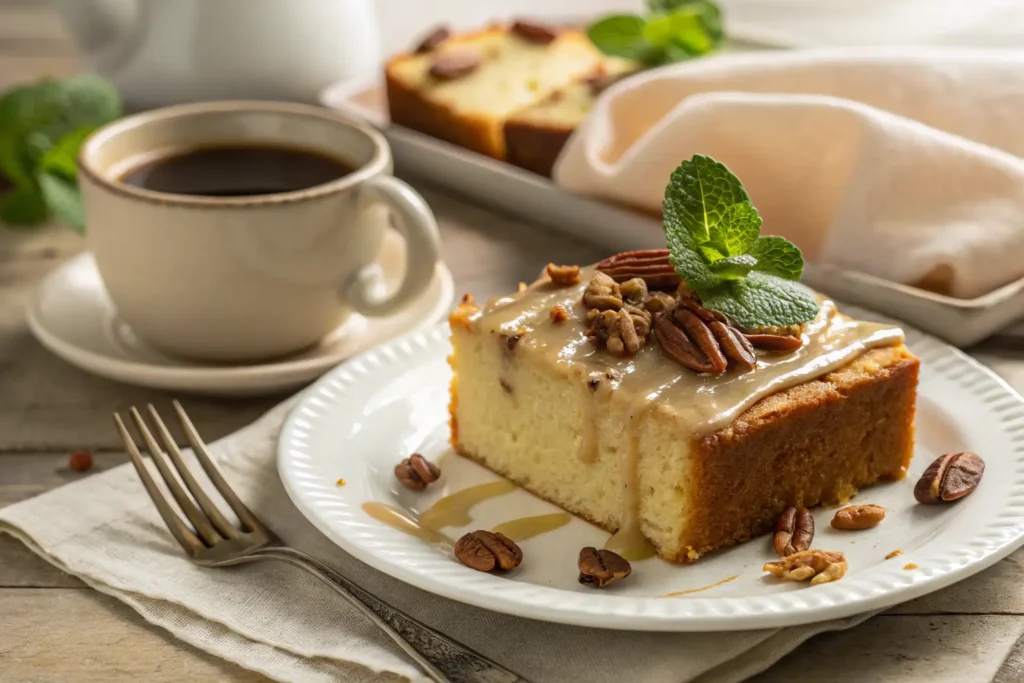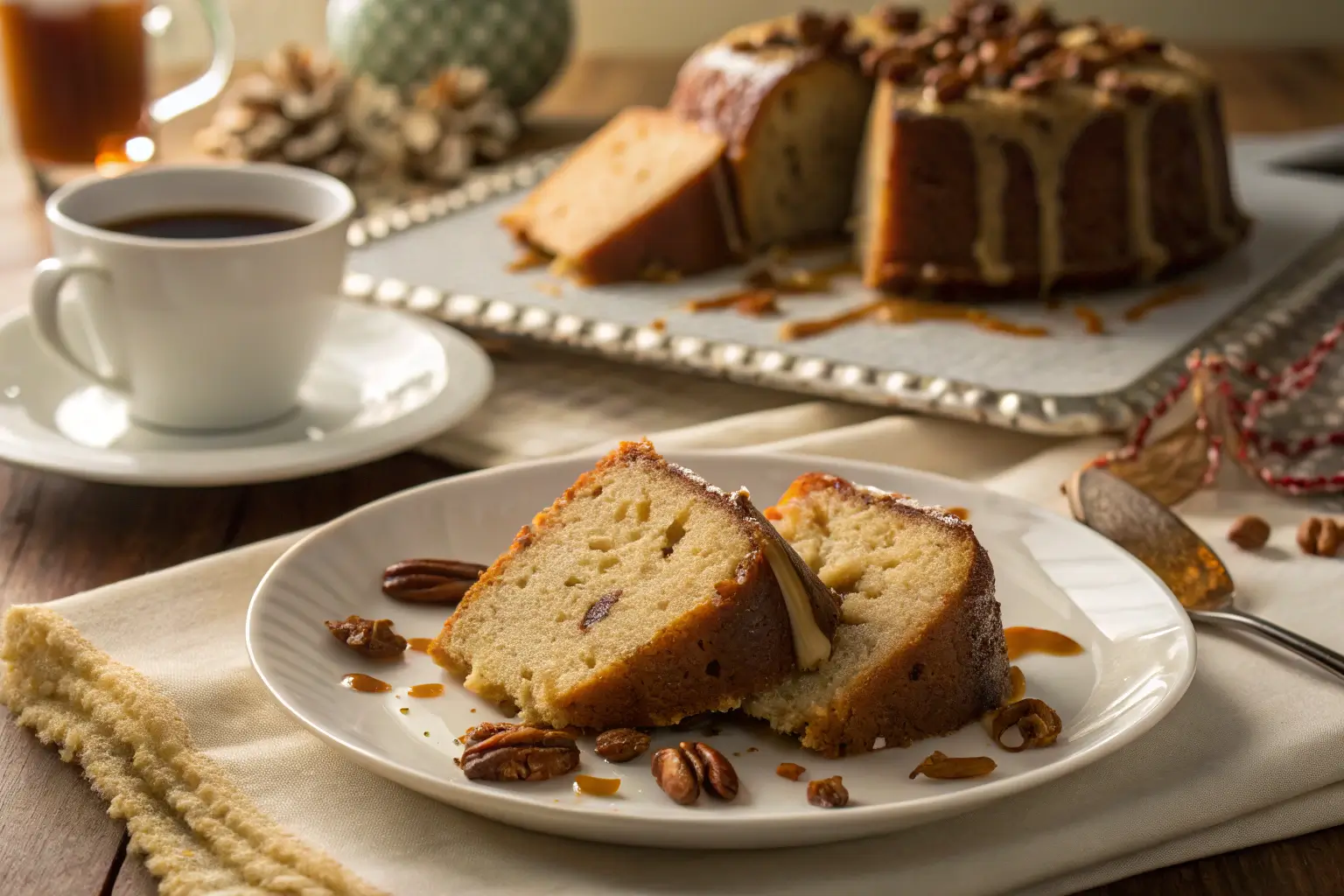Butter pecan pound cake is a delightful dessert that blends the rich, buttery flavor of classic pound cake with the nutty sweetness of toasted pecans. It’s a treat that feels right at home on the table for any occasion—whether it’s a holiday feast, a family get-together, or just an indulgent afternoon snack. In this guide, we’ll dive deep into everything you need to know about this Southern classic. From understanding the perfect ingredients to mastering the baking process and adding the perfect glaze, we’ve got it all covered. Let’s get started!
Introduction to Butter Pecan Pound Cake
The Allure of Butter Pecan Desserts
Butter pecan desserts have always been a crowd favorite, and for good reason. The combination of buttery richness and the earthy crunch of pecans creates a flavor that’s indulgent yet comforting. Whether it’s butter pecan ice cream, cookies, or our beloved pound cake, this flavor profile consistently delivers satisfaction. The pound cake variation takes this classic up a notch by pairing it with a dense, moist texture that’s truly irresistible.
What Defines a Pound Cake?
Traditional pound cakes date back centuries and were originally made with a pound each of butter, sugar, eggs, and flour. This simple ratio creates a dense yet soft cake with a fine crumb. Over time, bakers have introduced variations, like the butter pecan pound cake, which incorporates toasted pecans and sometimes a rich glaze to elevate the experience. This cake is all about balance—its hearty structure contrasts beautifully with the subtle crunch and caramelized flavor of the pecans.
Ingredients You’ll Need for Butter Pecan Pound Cake
Essential Components for a Moist Pound Cake
Creating the perfect butter pecan pound cake starts with high-quality, carefully chosen ingredients. Each component plays a vital role in achieving the cake’s signature flavor and texture. The essentials include butter, sugar, eggs, flour, and a touch of salt. Butter, of course, is the star here. Make sure to use real, unsalted butter for that rich, creamy taste. Pair this with granulated sugar to create the ideal sweetness.
Eggs add structure and moisture, while all-purpose flour gives the cake its dense crumb. A pinch of salt might seem minor, but it enhances the overall flavor, balancing the sweetness beautifully.
Incorporating Pecans: Selection and Preparation
The pecans are what elevate this pound cake into something truly special. For the best results, choose fresh, high-quality pecans with no bitterness. Toasting the pecans beforehand brings out their natural oils, making them more flavorful and aromatic. Simply spread them on a baking sheet and toast at 350°F (175°C) for 5–7 minutes, stirring occasionally. Once toasted, chop them coarsely to ensure they’re evenly distributed throughout the batter.
Flavor Enhancers: Vanilla Extract and Beyond
No butter pecan pound cake would be complete without a touch of vanilla extract. This ingredient deepens the flavor, adding a warm, aromatic note that pairs perfectly with the butter and pecans. For an extra twist, consider incorporating a hint of maple syrup or even a splash of bourbon. These additions complement the nuttiness of the pecans and give the cake a more complex, indulgent flavor.
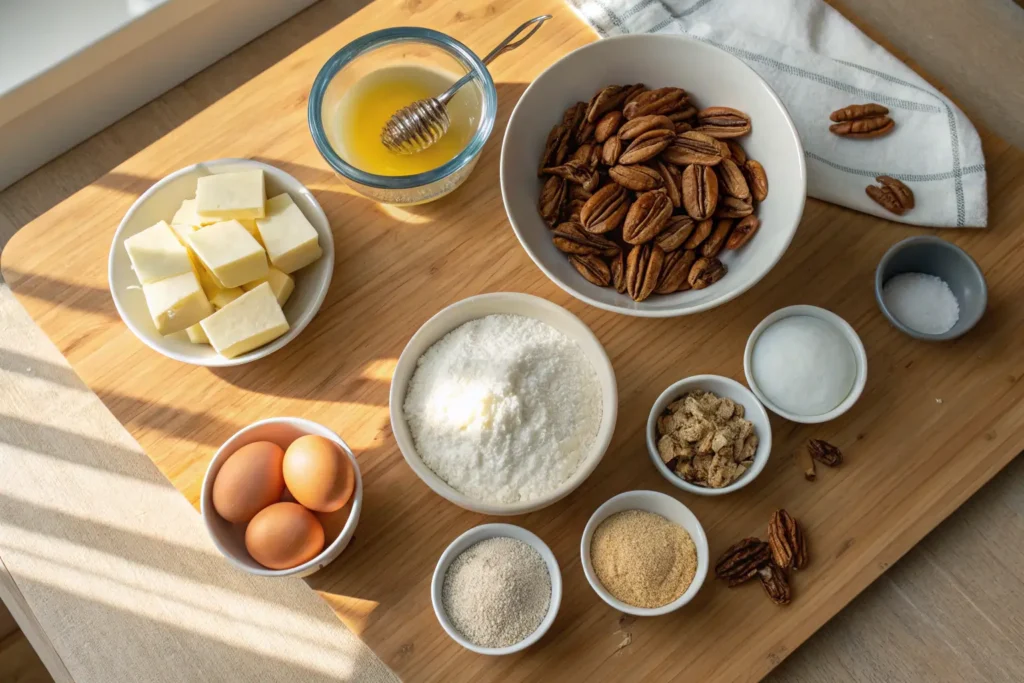
Step-by-Step Guide to Making Butter Pecan Pound Cake
Preparing Your Ingredients for the Best Results
Before you start mixing your batter, take the time to prepare your pecans. Toasting them not only enhances their flavor but also adds a subtle crunch to the cake. Preheat your oven to 350°F (175°C) and spread the pecans on a baking sheet in a single layer. Bake for about 5–7 minutes, stirring halfway through, until they’re golden and fragrant. Once cooled, chop them coarsely and set aside.
Mixing the Batter
Creating the batter is where the magic begins. Start by creaming the butter and sugar together until the mixture is light and fluffy—this step is crucial for achieving a moist, tender cake. Next, add the eggs one at a time, beating well after each addition. This helps to incorporate air into the batter, giving the cake its lift.
In a separate bowl, sift together the dry ingredients: flour, baking powder, and a pinch of salt. Gradually add the dry mixture to the wet ingredients, alternating with milk or buttermilk. This method ensures a smooth, lump-free batter. Finally, fold in the vanilla extract and those perfectly toasted pecans. Be gentle here—overmixing can lead to a dense cake.
Baking and Cooling Your Butter Pecan Pound Cake
Now that your batter is ready, it’s time to bake. Preheat your oven to 325°F (163°C) and grease a Bundt pan or loaf pan generously with butter or non-stick spray. Pour the batter into the pan, smoothing the top with a spatula for an even bake. Place the pan in the oven and bake for 60–75 minutes, or until a toothpick inserted into the center comes out clean.
Cooling and Removing from Pan
Once the cake is baked to golden perfection, remove it from the oven and let it cool in the pan for about 10 minutes. Then, gently invert it onto a wire rack to cool completely. This step is key—trying to remove the cake too soon can cause it to break apart. Let the cake cool completely before adding any glaze or slicing into it.
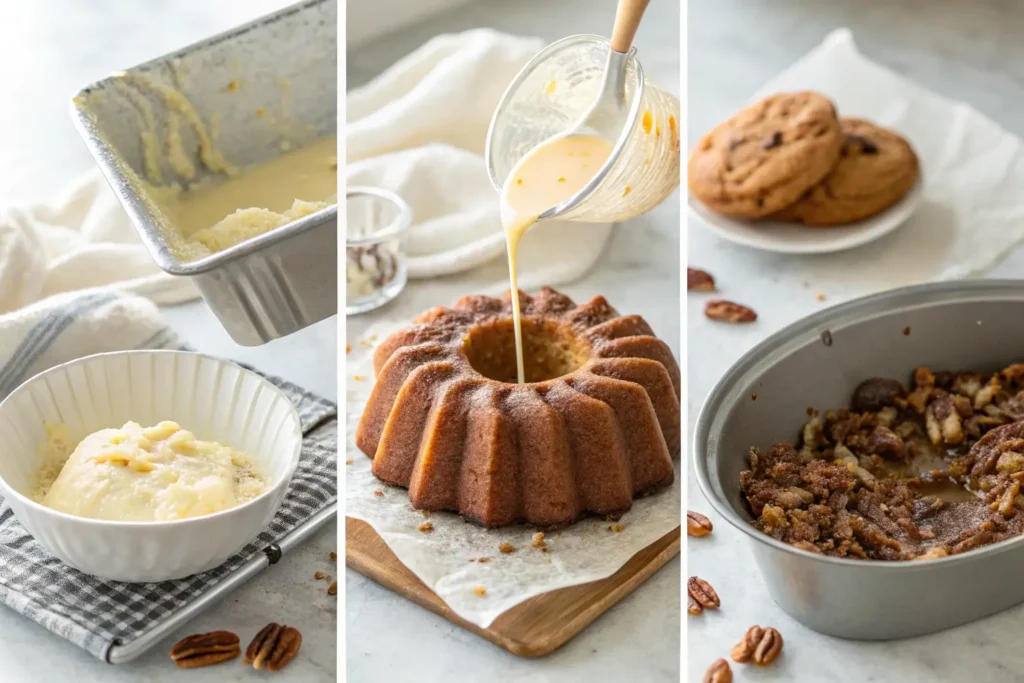
How to Make the Perfect Glaze for Butter Pecan Pound Cake
Choosing the Right Glaze for Butter Pecan Pound Cake
A well-chosen glaze can elevate your butter pecan pound cake from delightful to unforgettable. While the cake itself boasts rich, buttery flavors complemented by toasted pecans, the glaze adds a sweet finishing touch that ties everything together. Popular choices include vanilla glaze, caramel drizzle, or even a maple-infused icing. Each option brings its own unique flavor profile, enhancing the overall taste experience.
Glaze Preparation Steps
Creating a simple yet delicious glaze is straightforward. For a classic vanilla glaze, you’ll need:
- 1 cup of powdered sugar
- 2 tablespoons of milk or cream
- 1 teaspoon of pure vanilla extract
In a medium bowl, whisk together the powdered sugar and vanilla extract. Gradually add the milk, one tablespoon at a time, until you achieve a smooth, pourable consistency. If you prefer a thicker glaze, use less milk; for a thinner glaze, add a bit more. Ensure the mixture is free of lumps for a seamless application.
Applying the Glaze
Before glazing, allow your butter pecan pound cake to cool completely. This prevents the glaze from melting and ensures it adheres properly. Place the cake on a wire rack with parchment paper underneath to catch any excess glaze. Using a spoon or a small pitcher, drizzle the glaze over the top of the cake, allowing it to cascade down the sides naturally. For a more polished look, you can use a spatula to spread the glaze evenly. Let the glaze set for about 15–20 minutes before serving, allowing it to harden slightly and create a delightful texture contrast.
Serving and Pairing Your Butter Pecan Pound Cake
Ideal Accompaniments
Serving your butter pecan pound cake with thoughtful accompaniments can enhance its flavors and provide a well-rounded dessert experience. Consider pairing slices with a dollop of freshly whipped cream or a scoop of vanilla bean ice cream. The creaminess complements the cake’s dense texture, while the coolness contrasts with its rich, buttery warmth. Fresh fruits, such as sliced strawberries or a handful of blueberries, add a refreshing brightness that balances the cake’s sweetness.
Presentation Tips to Impress Your Guests
Presentation plays a key role in elevating your dessert. To make your butter pecan pound cake visually appealing, consider garnishing it with a sprinkle of chopped toasted pecans on top of the glaze. This not only hints at the flavors within but also adds a pleasing crunch. Serving the cake on a decorative platter and adding a few mint leaves or edible flowers can further enhance its aesthetic appeal. Remember, we eat with our eyes first, so a beautifully presented cake is sure to impress your guests.
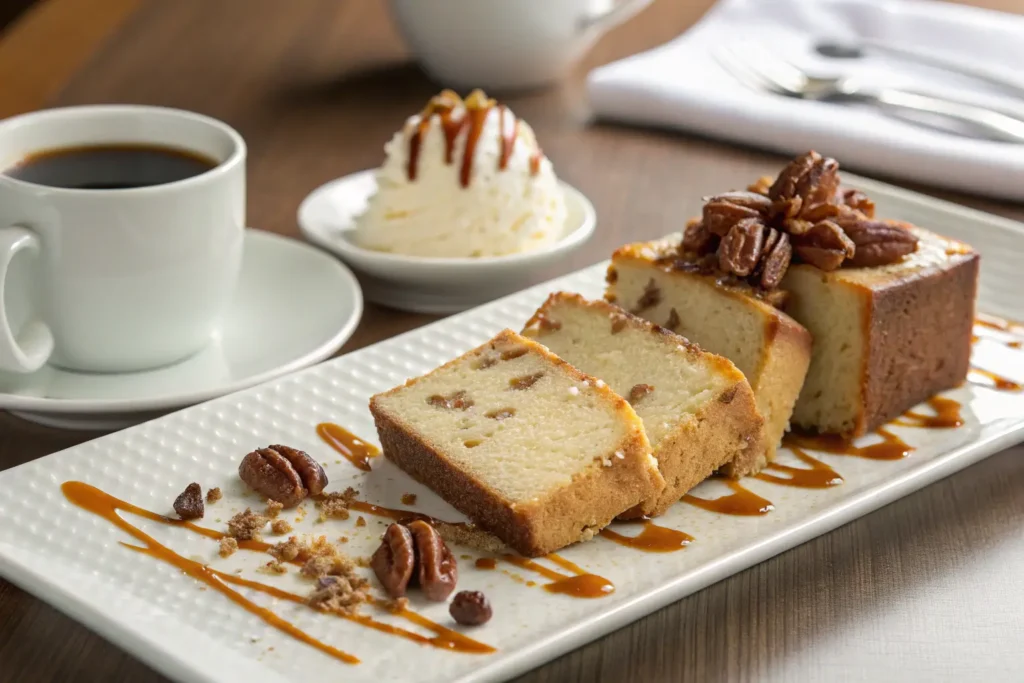
Storage and Shelf Life of Butter Pecan Pound Cake
How to Store Butter Pecan Pound Cake Properly
Keeping your butter pecan pound cake fresh requires a few simple steps. Once the cake has cooled completely, wrap it tightly in plastic wrap or aluminum foil to prevent it from drying out. If you prefer, you can store the cake in an airtight container, which helps lock in moisture and flavor. Always store the cake at room temperature if you plan to consume it within a couple of days. Keeping it away from direct sunlight or heat sources ensures it stays as fresh as possible.
Freezing Butter Pecan Pound Cake for Long-Term Enjoyment
For longer storage, freezing your cake is an excellent option. To freeze, first wrap the entire cake—or individual slices—in plastic wrap. Then, place it in a freezer-safe bag or container for added protection. This prevents freezer burn and preserves the rich, buttery flavor. When you’re ready to enjoy the cake, simply thaw it at room temperature for a few hours. The texture and taste will remain just as delightful as the day you baked it.
How Long Does Butter Pecan Pound Cake Stay Fresh?
A properly stored butter pecan pound cake will stay fresh for up to 3 days at room temperature. If refrigerated, it can last up to a week. When frozen, it can maintain its quality for up to three months, making it a great make-ahead dessert for special occasions.
Exploring Variations of Butter Pecan Pound Cake
Incorporating Chocolate or Caramel
If you’re looking to add a creative twist to your butter pecan pound cake, consider incorporating chocolate or caramel. For more dessert inspiration, explore How to Make the Perfect Salmon Teriyaki Bowl at Home for a sweet and savory twist to your menu. .Adding chocolate chips to the batter provides a sweet surprise in every bite, while swirling caramel into the mix before baking creates a rich, gooey texture. These flavors complement the buttery and nutty essence of the cake, making it even more indulgent. For a finishing touch, drizzle extra caramel sauce over the cake after it has cooled—it’s a guaranteed crowd-pleaser!
Mini Pound Cakes or Cupcakes
Another fun variation is to bake the batter into individual mini pound cakes or cupcakes. These smaller portions are perfect for parties, potlucks, or even as delightful homemade gifts. Adjust the baking time to about 20–25 minutes and use a toothpick to check for doneness. Top each mini cake with a dollop of glaze or whipped cream and a sprinkle of toasted pecans for a stunning presentation.
Seasonal Twists: Pumpkin or Apple Additions
To make your butter pecan pound cake more seasonal, try incorporating pumpkin puree or grated apple into the batter. Pumpkin adds a warm, spiced flavor that’s perfect for autumn, while apple contributes natural sweetness and a moist texture. Pair these additions with complementary spices like cinnamon, nutmeg, or allspice for a cake that feels cozy and festive.
Historical Background of Pound Cakes
Origins of the Pound Cake
The pound cake has a rich history that dates back to the 1700s, originating in Europe. Its name comes from the original recipe, which used a pound each of butter, sugar, eggs, and flour. This simple ratio made it easy for bakers to remember, even without written recipes. Over time, the recipe evolved to include additional ingredients like vanilla, milk, and leavening agents to enhance flavor and texture.
Regional Variations
As pound cakes spread across cultures, they took on unique regional twists. In the southern United States, the butter pecan pound cake became a beloved variation, reflecting the region’s love for buttery flavors and local pecans. Other cultures incorporated citrus, dried fruits, or alcohol into their pound cake recipes, creating desserts that catered to local tastes and traditions. Today, the pound cake continues to be a versatile and cherished dessert around the world.
Health Considerations and Modifications
Reducing Sugar or Fat Content
If you love hearty meals, check out Quick Lunch Recipes for Work: Your Complete Guide to Healthy Office Meals to balance your day with nutritious options.
If you love butter pecan pound cake but want to make it a bit lighter, you can reduce the sugar or fat content without sacrificing too much flavor. Start by cutting the sugar by 20–25%. You can also substitute half of the butter with unsweetened applesauce or Greek yogurt. These swaps help retain moisture and keep the cake tender while reducing overall calories. Remember, balance is key—overcompensating with substitutes might change the cake’s signature texture.
Allergen Substitutions
For those with dietary restrictions, there are easy ways to modify this recipe. If you’re avoiding dairy, opt for plant-based butter and milk alternatives like almond or oat milk. To make the cake nut-free, swap pecans with sunflower seeds or omit them entirely while enhancing the flavor with extra vanilla or spices. Gluten-free bakers can use a 1-to-1 gluten-free flour blend, which works well for maintaining the cake’s structure and density. These adjustments ensure everyone can enjoy the delightful taste of a butter pecan pound cake.
Reader Experiences and Testimonials
Success Stories from Home Bakers
Many readers have shared their love for this butter pecan pound cake recipe, praising its rich flavor and ease of preparation. One baker mentioned, “I made this cake for my family gathering, and everyone asked for seconds! Toasting the pecans made such a difference.” Another reviewer said, “I added a splash of maple syrup to the glaze, and it brought out the nutty flavors beautifully.” These stories highlight how versatile and foolproof this recipe can be, even for beginners.
Common Challenges and Solutions
While the recipe is straightforward, a few challenges might arise. For instance, some bakers find their cake turns out dry. This issue can often be resolved by checking the oven temperature with an oven thermometer and avoiding overmixing the batter. Others struggle with removing the cake from the pan cleanly. To prevent sticking, grease the pan thoroughly and let the cake cool for about 10 minutes before inverting it. These tips ensure a smooth and stress-free baking experience.
FAQs
What is the difference between a butter cake and a pound cake?
A butter cake and a pound cake may seem similar, but their differences lie in their texture, proportions, and history. Butter cake is typically lighter and fluffier, using a higher ratio of leavening agents like baking powder or baking soda to give it a soft crumb. On the other hand, a pound cake has a dense, rich texture and follows the traditional 1:1:1:1 ratio—one pound each of butter, sugar, eggs, and flour—making it hearty and substantial. While butter cakes are perfect for layered desserts, the butter pecan pound cake is a show-stopper on its own, with its buttery, nutty flavor shining through every bite.
What culture is pound cake from?
The pound cake originated in Europe, particularly in England, during the early 18th century. Its simplicity—requiring equal weights of basic ingredients—made it easy to bake without precise measurements. Over time, the recipe spread across continents and adapted to local tastes. In the Southern United States, the pound cake evolved into a beloved dessert, often featuring local ingredients like pecans, giving birth to variations like the butter pecan pound cake. Today, pound cakes are celebrated worldwide as a versatile treat that bridges history, culture, and culinary creativity.
How do you keep pound cake moist?
To keep a pound cake moist, focus on technique and storage. First, don’t overmix the batter—this can make the cake dense and dry. Always measure your ingredients accurately, especially flour, as too much can absorb extra moisture. Baking at the correct temperature ensures even cooking without over-drying the edges. Once baked, wrap the cooled cake tightly in plastic wrap or store it in an airtight container to preserve its moisture. For long-term storage, freeze the cake, and thaw it at room temperature before serving—it will taste as fresh as the day it was baked.
Is it better to use cake flour or all-purpose flour for pound cake?
Cake flour is generally better for pound cake because it has a lower protein content, which results in a softer, more tender crumb. It’s ideal for recipes like butter pecan pound cake, where a delicate texture complements the rich, buttery flavor. However, if you only have all-purpose flour, you can achieve similar results by removing two tablespoons of flour per cup and replacing them with cornstarch. This simple adjustment ensures your pound cake has the perfect balance of density and softness.
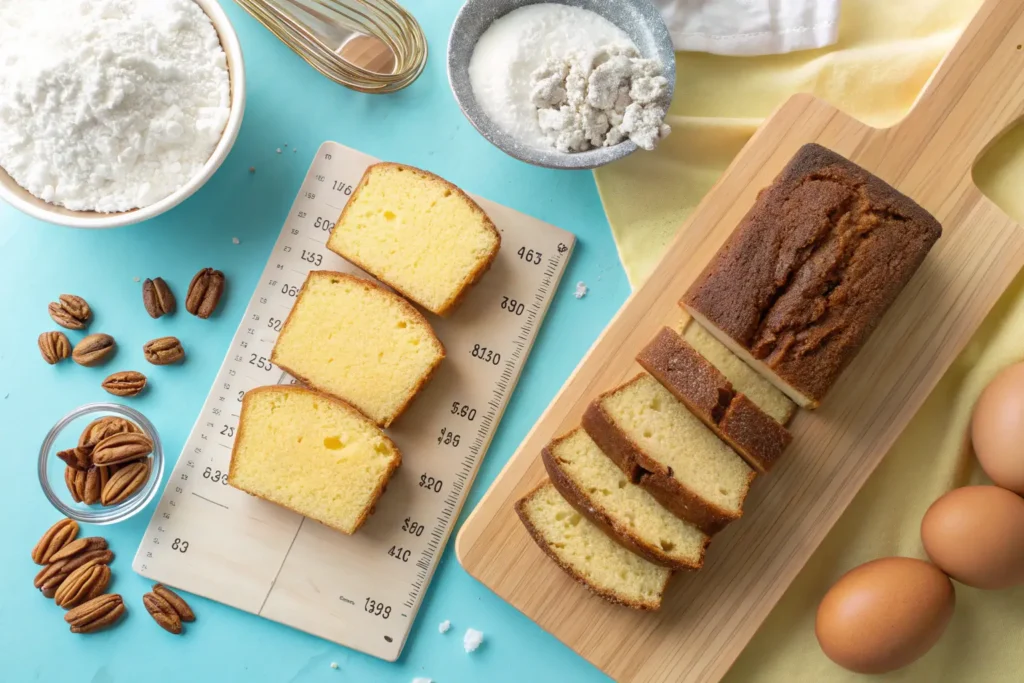
Conclusion
Encouragement to Try the Recipe
Baking a butter pecan pound cake is not just about creating a dessert—it’s about crafting a memorable experience. From the rich, buttery batter to the toasted pecans and that perfect glaze, every bite tells a story of comfort and indulgence. Whether you’re baking for a special occasion or a quiet evening at home, this recipe is sure to impress.
Call to Action for Comments and Shares
We’d love to hear from you! Have you tried this butter pecan pound cake recipe? Share your experience, tips, or creative variations in the comments below. Don’t forget to share this recipe with friends and family—it’s too good to keep to yourself!
